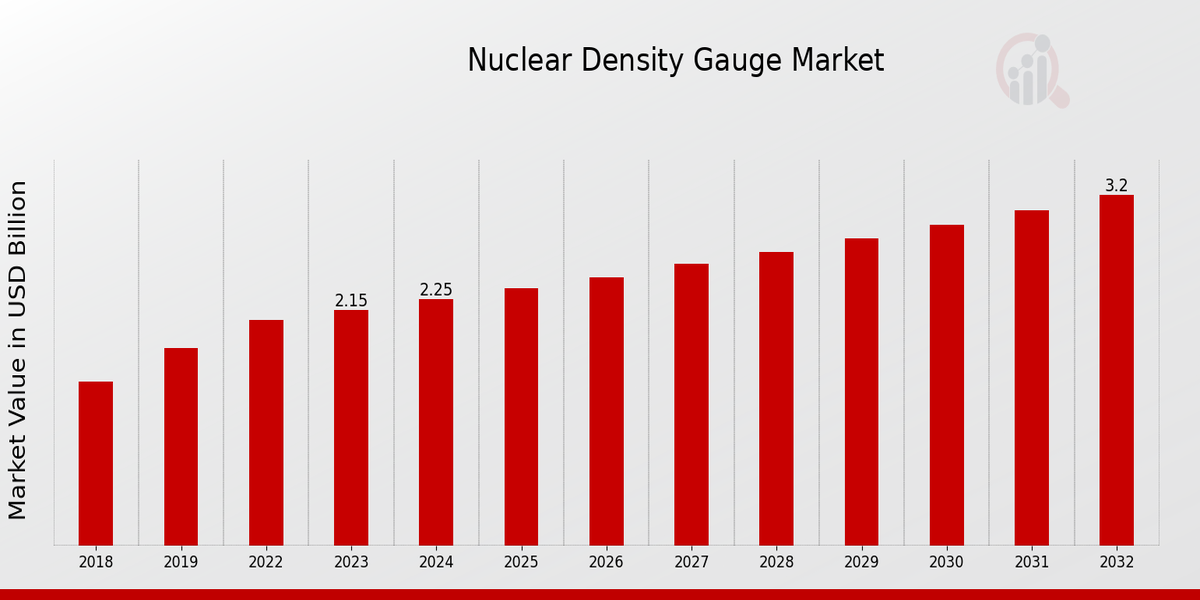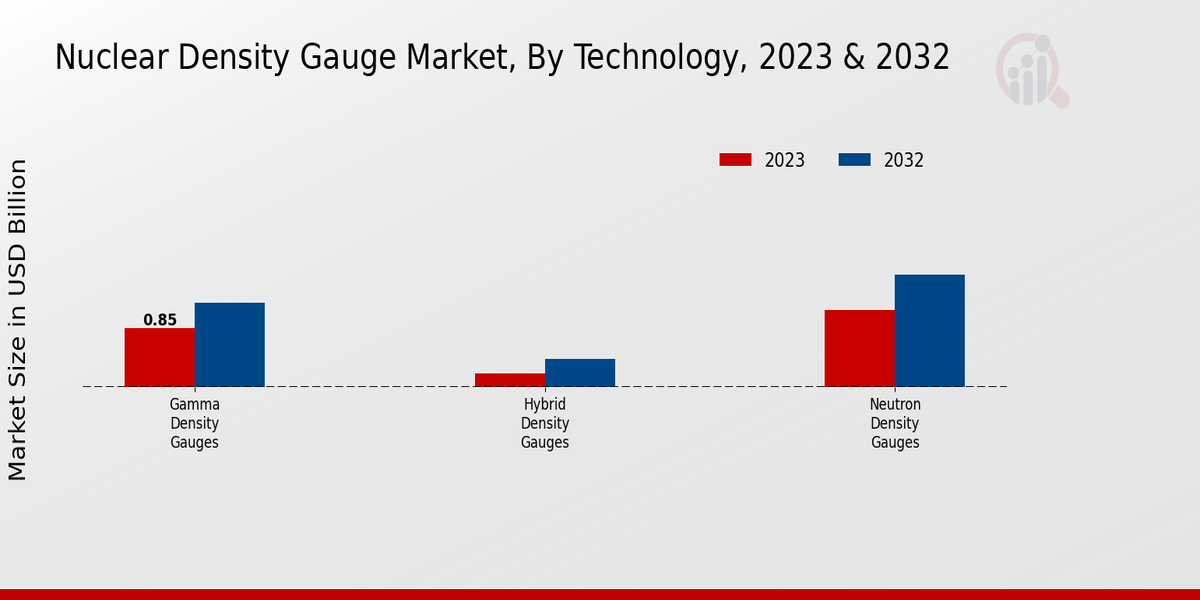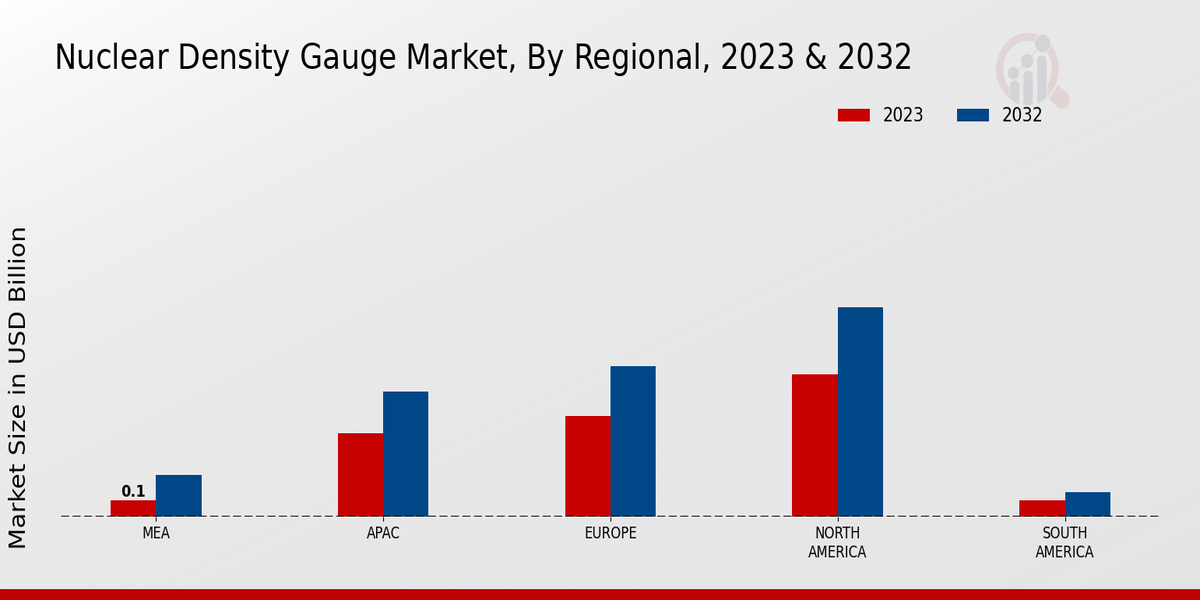Global Nuclear Density Gauge Market Overview:
Nuclear Density Gauge Market Size was estimated at 2.06 (USD Billion) in 2022. The Nuclear Density Gauge Market Industry is expected to grow from 2.15(USD Billion) in 2023 to 3.2 (USD Billion) by 2032. The Nuclear Density Gauge Market CAGR (growth rate) is expected to be around 4.53% during the forecast period (2024 - 2032).
Key Nuclear Density Gauge Market Trends Highlighted
The Nuclear Density Gauge Market is primarily driven by the increasing demand for accurate measurement devices in construction and civil engineering projects. As infrastructure development accelerates globally, the need for reliable materials testing and quality assurance becomes essential. This trend is further supported by stringent regulations and safety standards in various industries that necessitate precise density measurements for materials such as soil and concrete. Additionally, technological advancements in nuclear density gauges, including enhanced portability and user-friendly interfaces, contribute to their growing adoption across various sectors.
There are significant opportunities to be explored, particularly in emerging markets where rapid urbanization and infrastructural development are underway. As these regions invest in modern construction practices, the demand for advanced testing equipment is expected to rise. The introduction of smart technologies and IoT integration can also pave the way for innovative solutions, enabling real-time data analysis and improved efficiency. Moreover, the expanding application of nuclear density gauges beyond traditional sectors, including environmental monitoring and geological studies, presents new avenues for growth and diversification.
In recent times, there has been a noticeable shift toward more sustainable practices within the construction industry, prompting an increased focus on materials that reduce environmental impact. This trend aligns with the growing awareness of sustainability among consumers and regulatory bodies, encouraging companies to adopt eco-friendly methods in their operations. As a result, the Nuclear Density Gauge Market is likely to evolve, embracing technologies that not only meet measurement needs but also adhere to sustainability goals.

Source: Primary Research, Secondary Research, MRFR Database and Analyst Review
Nuclear Density Gauge Market Drivers
Growing Demand for Construction and Infrastructure Projects
The Nuclear Density Gauge Market Industry is experiencing significant growth driven by the increasing demand for construction and infrastructure projects worldwide. As nations strive to improve their infrastructure, including roads, bridges, and buildings, the need for precise material density measurement has become critical. Nuclear density gauges are renowned for their accuracy and reliability in measuring various materials used in construction, such as soil, asphalt, and concrete.The expansion of urban areas, along with the refurbishment of existing structures, propels the need for nuclear density gauges. Moreover, governments are investing heavily in public infrastructure development to stimulate economic growth, which further boosts the demand for these advanced measurement tools. The ability of nuclear density gauges to provide real-time data aids in ensuring compliance with engineering standards and regulations, thus enhancing their appeal among construction professionals.As urbanization continues to escalate, the prospects for the Nuclear Density Gauge Market Industry remain robust, with these gauges positioned as essential instruments for achieving high-quality construction outcomes.
Technological Advancements in Nuclear Density Gauges
Technological advancements in nuclear density gauges are a significant driving force in the Nuclear Density Gauge Market Industry. Innovations such as improved measurement accuracy, reduced size and weight of the gauges, and enhanced user interfaces make these devices more effective and user-friendly. The integration of modern electronic components allows for better data analysis and wireless connectivity, enabling real-time monitoring and reporting of density measurements.These advancements not only increase the efficiency of construction projects but also cater to the evolving needs of various industries looking for more precise and reliable measurement solutions. As technology continues to evolve, it will likely open new avenues for application and growth within the market.
Regulatory Compliance and Quality Control Requirements
Another prominent driver for the Nuclear Density Gauge Market Industry is the increasing emphasis on regulatory compliance and quality control in construction and manufacturing processes. Many industries are subject to strict regulations regarding materials used in construction, and nuclear density gauges play a vital role in ensuring that these standards are met. The need for accurate density measurements helps prevent costly structural failures and maintains safety standards in projects.As regulatory bodies continue to tighten guidelines, companies are compelled to adopt advanced measurement technologies, further driving the demand for nuclear density gauges.
Nuclear Density Gauge Market Segment Insights:
Nuclear Density Gauge Market Technology Insights
The Nuclear Density Gauge Market is experiencing notable growth, driven by increasing demand in various applications such as construction, mining, and environmental monitoring. In 2023, the market is valued at 2.15 USD Billion and demonstrates a market growth driven by advancements in technology and increasing regulatory requirements for quality control in materials. Within the technology segment, Gamma Density Gauges substantially dominate the market, valued at 0.85 USD Billion in 2023 and expected to grow to 1.2 USD Billion by 2032. This segment is pivotal in the industry due to its widespread adoption for density measurement applications, showcasing significant accuracy and reliability. Following closely is the Neutron Density Gauges segment, which holds a market value of 1.1 USD Billion in 2023 and is projected to rise to 1.6 USD Billion by 2032. This technology is essential for applications where materials have high levels of hydrogen, such as in concrete or during the evaluation of soil for construction projects, thus maintaining a critical role in the industry. In contrast, the Hybrid Density Gauges segment, although projected to grow from 0.2 USD Billion in 2023 to 0.4 USD Billion by 2032, holds the least market share but still represents an essential niche utilized in applications requiring versatility from both gamma and neutron sources.The segmentation of the Nuclear Density Gauge Market highlights the diverse technologies available, with Gamma and Neutron Density Gauges capturing the majority holding due to their robust applications and reliability in various industrial settings. The ongoing advancements in this technology collectively contribute to enhancing measurement precision and operational efficiency for users. The market's growth is further supported by increasing investments in research and development to explore new applications and improve existing technologies.Challenges remain, particularly concerning regulatory compliance and safety measures surrounding nuclear technology, yet opportunities abound in emerging markets and sectors looking for enhanced density measurement solutions. As the Nuclear Density Gauge Market continues to evolve, understanding the dynamics and insights within the technology segment is crucial for stakeholders looking to navigate this space effectively.

Source: Primary Research, Secondary Research, MRFR Database and Analyst Review
Nuclear Density Gauge Market Application Insights
The Nuclear Density Gauge Market, valued at 2.15 USD Billion in 2023, shows substantial growth across various applications, each contributing significantly to its expansion. The market segmentation comprises key areas such as Construction, Mining, Oil and Gas, Environmental Monitoring, and Agriculture. The Construction industry benefits from nuclear density gauges by ensuring optimal material compaction and moisture content, which is crucial for structural integrity. In Mining, these gauges play an important role in the accurate measurement of material density, promoting efficiency and safety.The Oil and Gas sector utilizes this technology to enhance drilling operations and optimize resource extraction, underlining its significance in this resource-intensive industry. Environmental Monitoring also demonstrates a notable application, where nuclear density gauges assist in assessing soil and waste material properties, supporting sustainable practices. Lastly, Agriculture leverages this technology to evaluate soil density, which is essential for improving crop yields. As such, the diverse applications underline the importance of the Nuclear Density Gauge Market, with each sector showcasing distinct growth drivers and opportunities for market growth.
Nuclear Density Gauge Market Measurement Type Insights
The Nuclear Density Gauge Market revenue is poised for growth, with a valuation of approximately 2.15 USD Billion in 2023 and expected to reach around 3.2 USD Billion by 2032. Within the market, Measurement Type plays a crucial role, encompassing various techniques that enhance accuracy in material assessments across industries such as construction and environmental monitoring. Density Measurement, a leading aspect, is instrumental for applications requiring precise material characterization, making it vital for ensuring quality control. Moisture Measurement is of equal importance, addressing the critical need for managing water content in materials such as soil and aggregates, directly impacting construction efficiency and project sustainability.Compaction Measurement is significant in assessing the structural integrity of soil and pavement, which is essential for infrastructure development. These various measurement approaches represent substantial market segments that cater to diverse industry demands, showcasing the importance of reliable nuclear density gauges in supporting construction safety and material integrity while adapting to evolving regulatory standards. The Nuclear Density Gauge Market statistics reflect a dynamic landscape driven by these pivotal measurement types, supporting continued innovation and market growth.
Nuclear Density Gauge Market End User Insights
The Nuclear Density Gauge Market has garnered substantial attention, especially within its End User segment, which includes diverse industries like construction, mining, environmental agencies, and agriculture. In 2023, the market valuation reached approximately 2.15 billion USD, reflecting a growing demand for precision measurement solutions across these sectors. Construction companies significantly utilize nuclear density gauges to ensure quality control during the building process, where accurate density measurements are critical. Mining firms also play a major role, as these tools aid in material analysis and resource management on-site.Environmental agencies leverage this technology for monitoring soil and waste density, promoting sustainable practices and efficient resource utilization. Lastly, the agricultural sector adopts nuclear density gauges to assess soil compaction and moisture levels, enhancing crop yield and quality. Collectively, these sectors contribute considerably to the Nuclear Density Gauge Market statistics, driving its evolution and presenting numerous opportunities for market growth amidst various challenges. The expected CAGR of 4.53 from 2024 to 2032 further illustrates the ongoing evolution and significance of this market as industries increasingly recognize the value of accurate density measurement technology.
Nuclear Density Gauge Market Regional Insights
The Nuclear Density Gauge Market is projected to achieve a valuation of 2.15 USD Billion in 2023, reflecting the significance of various regional markets in its growth trajectory. North America leads the market with a valuation of 0.85 USD Billion, attributed to its advanced industrial sectors and heightened need for precision measurement technology, thereby dominating the landscape. Following closely, Europe stands at 0.6 USD Billion, supported by robust infrastructure development and regulatory frameworks favoring nuclear density gauges.The Asia Pacific region, valued at 0.5 USD Billion, exhibits substantial growth potential due to increasing investments in construction and mining activities. The Middle East and Africa segment, although smaller at 0.1 USD Billion, is gradually gaining traction as infrastructure projects proliferate, while South America remains on the lower end with 0.1 USD Billion due to lesser industrial activity. These regional dynamics underscore the importance of adapting strategies to capitalize on emerging opportunities while addressing unique challenges within the Nuclear Density Gauge Market industry.Overall, the market growth across these regions is influenced by technological advancements and the necessity for precise measurements in various applications, highlighting opportunities for further market penetration.

Source: Primary Research, Secondary Research, MRFR Database and Analyst Review
Nuclear Density Gauge Market Key Players And Competitive Insights:
The Nuclear Density Gauge Market is characterized by a competitive landscape where various companies vie for market share by providing advanced solutions for measuring density in a variety of applications, particularly in civil engineering and construction. This market is essential for ensuring the quality and reliability of construction materials, thus leading to improved safety and compliance with regulatory standards. The stakeholders in this market include manufacturers, suppliers, and service providers that use cutting-edge technologies to enhance the accuracy and efficiency of nuclear density gauges. As demand for infrastructure projects rises globally, understanding the competitive dynamics within this market becomes crucial for companies looking to establish or maintain a robust presence. Raising Biogas has carved a niche for itself within the Nuclear Density Gauge Market by focusing on innovative solutions that enhance measurement accuracy. The company's strengths lie in its extensive research and development capabilities, allowing it to introduce cutting-edge technology that meets the evolving needs of clients in construction and materials testing. Raising Biogas has established a solid reputation for reliability in terms of product performance and customer service, which further supports its competitive edge. The commitment to sustainability and environmental safety paired with exceptional engineering expertise has enabled Raising Biogas to offer products that not only comply with industry standards but also contribute positively to environmental conservation, making it a sought-after player in this sector.Baker Hughes stands out in the Nuclear Density Gauge Market for its strong focus on technology-driven solutions and extensive industry experience. The company leverages its global footprint to provide high-quality nuclear density gauges that cater to diverse customer requirements. Known for its comprehensive product line that spans various industries, Baker Hughes maintains a strong market presence by investing in technological advancements and continuous product enhancements. This commitment to innovation ensures that Baker Hughes can meet the increasing demand for precision and reliability in density measurement while staying ahead of regulatory requirements. The company’s reputation for excellence and reliability makes it a significant competitor in the nuclear density gauge space, reinforcing its position as a leader in providing innovative solutions for the construction and civil engineering sectors.
Key Companies in the Nuclear Density Gauge Market Include:
Nuclear Density Gauge Market Industry Developments
Recent developments in the Nuclear Density Gauge Market have been driven by increasing demand for precise measurement tools in construction, civil engineering, and geological applications. Companies are focusing on technological advancements to enhance the efficiency and accuracy of nuclear density gauges with innovations in digital sensor technology and automation. Regulatory changes and safety standards in various regions are prompting manufacturers to improve safety features and compliance, which contributes to market growth. Furthermore, the market is experiencing heightened interest due to rising investments in infrastructure development and construction activities worldwide. As environmental concerns grow, there is a parallel trend toward exploring alternatives to traditional nuclear methods, fostering research into non-nuclear density measurement technologies. The global emphasis on sustainability and regulatory compliance is expected to reshape market dynamics, impacting both product offerings and consumer preferences in the forthcoming years. The market is projected to expand steadily, with notable growth opportunities anticipated up to 2032, as industries increasingly adopt nuclear density gauges for reliable material characterization and quality control.
Nuclear Density Gauge Market Segmentation Insights
Nuclear Density Gauge Market Technology Outlook
- Gamma Density Gauges
- Neutron Density Gauges
- Hybrid Density Gauges
Nuclear Density Gauge Market Application Outlook
- Construction
- Mining
- Oil and Gas
- Environmental Monitoring
- Agriculture
Nuclear Density Gauge Market Measurement Type Outlook
- Density Measurement
- Moisture Measurement
- Compaction Measurement
Nuclear Density Gauge Market End User Outlook
- Construction Companies
- Mining Firms
- Environmental Agencies
- Agricultural Sector
Nuclear Density Gauge Market Regional Outlook
- North America
- Europe
- South America
- Asia Pacific
- Middle East and Africa
| Report Attribute/Metric |
Details |
| Market Size 2022 |
2.06(USD Billion) |
| Market Size 2023 |
2.15(USD Billion) |
| Market Size 2032 |
3.2(USD Billion) |
| Compound Annual Growth Rate (CAGR) |
4.53% (2024 - 2032) |
| Report Coverage |
Revenue Forecast, Competitive Landscape, Growth Factors, and Trends |
| Base Year |
2023 |
| Market Forecast Period |
2024 - 2032 |
| Historical Data |
2019 - 2023 |
| Market Forecast Units |
USD Billion |
| Key Companies Profiled |
Raising Biogas, Baker Hughes, Alphacontrol, Krautkramer, Mistras Group, Teledyne Technologies, IsotopeSystems, Creaform, Walter Smart Technologies, Instrotech, MTS Systems Corporation, Geosense, Shawcor, Thermo Fisher Scientific |
| Segments Covered |
Technology, Application, Measurement Type, End User, Regional |
| Key Market Opportunities |
Technological advancements in sensors Increasing demand in construction industry Expansion in emerging markets Regulatory support for safety standards Integration with IoT solutions |
| Key Market Dynamics |
Growing demand in construction Increasing use in civil engineering Technological advancements in gauges Stringent safety regulations Rising need for soil testing. |
| Countries Covered |
North America, Europe, APAC, South America, MEA |
Frequently Asked Questions (FAQ) :
The Nuclear Density Gauge Market is expected to be valued at 2.15 USD Billion in 2023.
The market is projected to reach a value of 3.2 USD Billion by 2032.
The expected CAGR for the market from 2024 to 2032 is 4.53.
North America is projected to hold the largest market share, expected to be valued at 1.25 USD Billion in 2032.
Gamma Density Gauges are valued at 0.85 USD Billion in 2023 and projected to reach 1.2 USD Billion by 2032.
The Neutron Density Gauges market is anticipated to grow to 1.6 USD Billion by 2032.
The Hybrid Density Gauges market is projected to reach 0.4 USD Billion by 2032.
The APAC region is expected to be valued at 0.75 USD Billion in 2032.
Major players in the market include Raising Biogas, Baker Hughes, Alphacontrol, and Thermo Fisher Scientific.
The MEA region is expected to grow to a market value of 0.25 USD Billion by 2032.





























